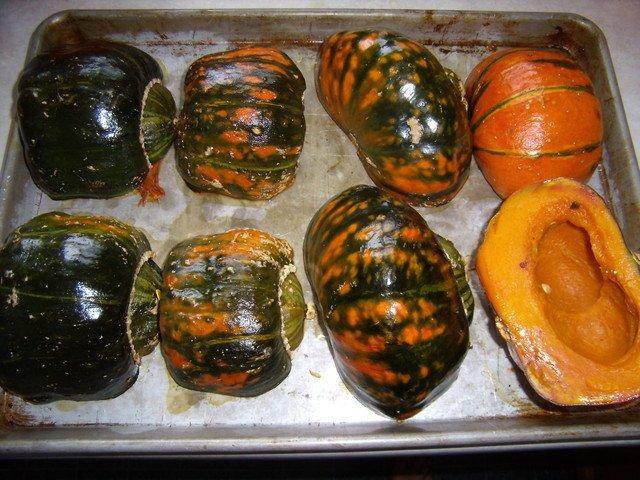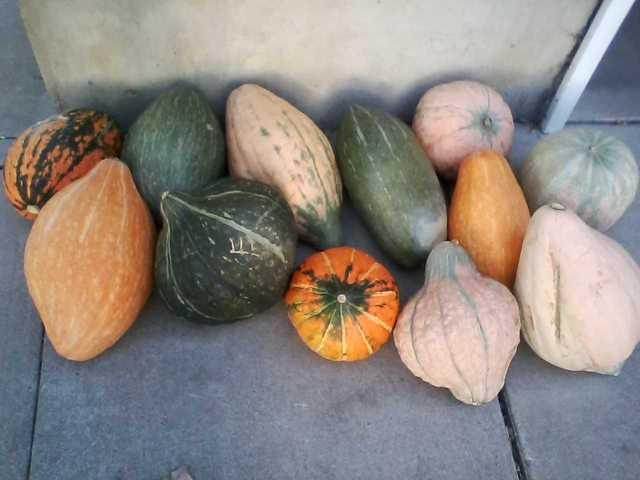

 2
2




Curtis Mullin wrote:Joseph! That is how you cook squash!?


 1
1




Joseph Lofthouse wrote:
Curtis Mullin wrote:Joseph! That is how you cook squash!?
Frying is my favorite way of preparing a little bit of squash in a hurry. If I am processing squash for seed, and need to taste a whole bunch of different squash on the same day, I tend to prefer frying, cause I can cut off a slab, and have a half dozen squash samples cooking at once, and cycle through lots of squash in an afternoon.
5 varieties of squash being fried at the same time...
For meals that are planned well in advance, that I want to be low fuss, I typically bake squash: These were for a family party. I was also saving seeds for planting and wanted to taste each fruit.
 1
1




 2
2




 1
1




Ryan Tollmann wrote:Being irish im fond of potatos, sliced and pan fried, baked, or cubed in stews...but they are a pain to dig up. That said heres a neat trick, plant them in crates/boxes with a sliding bottom kept just off the grown and in a place you want to add the soil...slip and a pile of loose dirt and potatoes magically appear.. hope that helps potato lovers...tollmann family garden trick.
 2
2




Pigs will dig them quite successfully. Seems they eat the roots but leave the actual tubers alone, so all you have to do is collect them. There's some collateral damage of bitten potatoes, but it doesn't seem too heavy.
 4
4





"People may doubt what you say, but they will believe what you do."
 2
2




"People may doubt what you say, but they will believe what you do."
 1
1





 2
2




Todd Parr wrote:I got squash seeds from Joseph this year, and the squash are enormous! Can someone tell me if they are ripe yet? I would expect that they have to be, because the plants are dying, but most of them have little to no orange. The ones that do just have spots. I guess I expected them to turn completely orange, although I'm not sure why





Joseph Lofthouse wrote: I do not fertilize my gardens, and don't weed much, and irrigate sparingly,
Idle dreamer

 1
1




Tyler Ludens wrote:I remember once you posted that you water once a week for six hours, which to me seems like a lot of irrigation.




Idle dreamer
 2
2




Joseph Lofthouse wrote: I'm laughing about the size... I do not fertilize my gardens, and don't weed much, and irrigate sparingly, so when they get to a garden where they are better cared for, they can really thrive.
"People may doubt what you say, but they will believe what you do."

 3
3




Todd Parr wrote:I put these squash in pretty late for the year, planted the seeds directly in the ground.
 2
2






 2
2








Joseph Lofthouse wrote:
Deb: I already have grand plans for what variety gets to grow up the tree next year: Those lagenaria snake squash.

 6
6




 1
1





"People may doubt what you say, but they will believe what you do."
 1
1




 A little more love though from me will make for a better season next year, but they are generally thrive despite neglect, totally astounding stuff.
A little more love though from me will make for a better season next year, but they are generally thrive despite neglect, totally astounding stuff.
 1
1




 2
2




"People may doubt what you say, but they will believe what you do."
 3
3




Maureen Atsali
Wrong Way Farm - Kenya




"When you want to climb a tree you don't begin at the top"

 1
1




I cook mostly small cream and milk based very spiced curries and wots, eaten with large bowls of kefirs and small serving of injera or couscous. Looking for a low input winter ephemeral like a cool but not cold hardy fonio or teff that'll grow like "wild" oats through the winter with surface scratching or fire followed by free sowing.
Hans Albert Quistorff, LMT projects on permies Hans Massage Qberry Farm magnet therapy gmail hquistorff
 2
2








Idle dreamer




Lynn Garcia wrote:Tyler.
Do you have a lot of rocks on your land? You could build rock piles to do some of the irrigation work for you. I lived in Helena, MT during my grade school and high school years, and the land we owned was all from past stream beds so tons of various sized rocks. In order to even begin a garden we had to yank out masses of various sized cobbles. We stacked them in piles to get them out of the way to build our garden beds. Then noticed there were soon green things growing madly near them. The Helena valley is one inch of rain a year from being a desert in the best of years. So as we built our garden plots we created some small rock walls around the beds. We still had to irrigate but it did cut down on how often we needed to. This might help you get some added drought resistance for your staple crops of choice. It worked in Helena with pretty low average humidity so it might help buffer you in Texas a bit. My Aunt lives in Arizona and does something similar in her gardens.
 1
1




Casie Becker wrote:
I missed this the last time I read the thread. How big do these rock piles need to be to show benefit? I line almost all my beds with rocks, but it's just a single layer.




Mick Fisch wrote:I'm stuck on the oil/fat production question. Carbs I can get, but historically the most prized item and the hardest thing to get a lot of was fat (ok, I can hear you guys already gearing up about olive oil in the mediteranean, pork fat in northern europe, coconut in polynesia). Every culture has come up with some solution, but we need fat.
I have been thinking about that one as well... I was a fruitarian for some time, and then it is recommended to eat very little fat, actually much less then we would dream of. Imagine, if eating avocados, being recommended to eat only one third, otherwise your you'd have exeded your fat ration (and fruitarians eat no oils, and normally no nuts). It is actually possible to live with less fat, especially in warmer climates. This is my experience, the colder it gets, the more we crave fatty foods.
I really don't believe in seed oils. Bacon, nut oil are some options for colder countries. One way of getting live animal fat (but not in that big quantities) is to raise waxies, that is, waxworms, they are living in beehives and live off the honey, and are very fatty and tasty... yeah, I know, most people are not ready for this, but somehow, grubs will become more common in the future, also for proteins and zinc, etc... (most vegans/vegetarians have a copper overload, and not enough zinc, found mostly in meat and grubs)
I still believe that we eat too much fats. I realise how easy it is to overdo the fats, but also that it really is possible to live on less fats. Better to go for high quality stuff.
 1
1




 1
1




Yes, I'm that David The Good. My books are here: http://amzn.to/2kYcCKp. My daily site is here http://www.thesurvivalgardener.com and my awesome videos are here https://www.youtube.com/subscription_center?add_user=davidthegood

|
Without deviation from the norm, progress is not possible - Zappa. Tiny ad:
Freaky Cheap Heat - 2 hour movie - HD streaming
https://permies.com/wiki/238453/Freaky-Cheap-Heat-hour-movie
|





